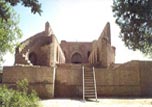 New Page 1
New Page 1
|
Tour in Central Governorates
Historical Sites
Baghdad:
-
Mustansiriya school:
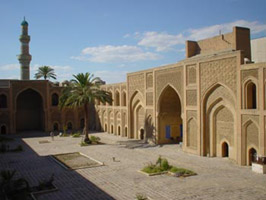 The Mustansiriya school with courses in Arabic,
Theology, Astronomy, Mathematics, Pharmacology, and Medicine with
application hospital, was the most prominent university in the Islamic
world of Abassids. It overlooks the Tigris from the Rusafa side, near
Shuhada bridge. It took six years to build in the reign of the 37th
Abbasid Caliph Al-Mustansir Billah (A.D. 1226 – 1242), after whom it was
called. Nearly three quarters of a million dinars in gold was spent on
its construction and had an endowment valued at about one million dinars
in gold from which the school obtained an annual revenue of 70,000
dinars to spend on staff and students. It has a quasi-rectangular plan
measuring 104.8 meters in length and 44.2 in width in the north, 48.8 in
the south, making up an area of 4836 square meters. The built up part
totals 3121 square meters, the rest being a courtyard of 1710 square
meters lined on all sides by ewans – Large ornamented galleries
completely open to the courtyard. There are rooms on two stories which
were for students lodging, study and lecture halls, a library (which
once held 80,000 books), a kitchen, a bathroom and notably, a pharmacy
attached to a hospital. It has its own garden, together with a house
once specially used for the study of the Kuran and another for the study
of Hoy tradition. Mustansiriya was also famous for its clock which told
the hours astronomically: a part from telling the hours, it specified
the position of the sun and the moon at every hour, besides other
mechanical curiosities. The Mustansiriya school with courses in Arabic,
Theology, Astronomy, Mathematics, Pharmacology, and Medicine with
application hospital, was the most prominent university in the Islamic
world of Abassids. It overlooks the Tigris from the Rusafa side, near
Shuhada bridge. It took six years to build in the reign of the 37th
Abbasid Caliph Al-Mustansir Billah (A.D. 1226 – 1242), after whom it was
called. Nearly three quarters of a million dinars in gold was spent on
its construction and had an endowment valued at about one million dinars
in gold from which the school obtained an annual revenue of 70,000
dinars to spend on staff and students. It has a quasi-rectangular plan
measuring 104.8 meters in length and 44.2 in width in the north, 48.8 in
the south, making up an area of 4836 square meters. The built up part
totals 3121 square meters, the rest being a courtyard of 1710 square
meters lined on all sides by ewans – Large ornamented galleries
completely open to the courtyard. There are rooms on two stories which
were for students lodging, study and lecture halls, a library (which
once held 80,000 books), a kitchen, a bathroom and notably, a pharmacy
attached to a hospital. It has its own garden, together with a house
once specially used for the study of the Kuran and another for the study
of Hoy tradition. Mustansiriya was also famous for its clock which told
the hours astronomically: a part from telling the hours, it specified
the position of the sun and the moon at every hour, besides other
mechanical curiosities.
-
Abbasid palace:
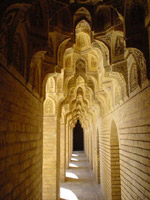 Near north gate on the river. It is believed to have
been built by the Caliph Al-Nasir lidillah (A.D. 1179 – 1225), in whose
reign other notable institutions were built. It has a central courtyard
and two stories of rooms, with beautiful arches and muqarnases in
brickwork. It has a remarkable ewan with brickwork ceiling and façade.
When it was partly reconstructed in recent times another ewan was built
to face it. Because of the palace’s resemblance in plan and structure to
Mustansiriya school, some scolars believe it is actually the Sharabiya
school, mentioned by the old Arab historians. Parts of the building were
reconstructed, whereupon a collection of historical remains were
exhibited in it representing certain stages of the country’s Arab
Islamic history. Near north gate on the river. It is believed to have
been built by the Caliph Al-Nasir lidillah (A.D. 1179 – 1225), in whose
reign other notable institutions were built. It has a central courtyard
and two stories of rooms, with beautiful arches and muqarnases in
brickwork. It has a remarkable ewan with brickwork ceiling and façade.
When it was partly reconstructed in recent times another ewan was built
to face it. Because of the palace’s resemblance in plan and structure to
Mustansiriya school, some scolars believe it is actually the Sharabiya
school, mentioned by the old Arab historians. Parts of the building were
reconstructed, whereupon a collection of historical remains were
exhibited in it representing certain stages of the country’s Arab
Islamic history.
-
Murjania school:
Known today as (Murjan Mosque), this school is in
Shorja, in Rasheed street. It was built by Aminuddin Murjan in 1357,
that is a century after the end of the Abbasids. In its early days it
had rooms for students, like Mustansiriya, but early in the 20th century
the school was pulled down, except for some parts, and replaced by a
mosque.
-
Khan Murjan:
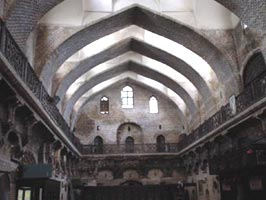 Lying opposite the school, it was, together with other
buildings and orchards, an endowment to help maintain the school and its
scholars. Architecturally, the Khan is extremely interesting. It is
built round a great central hall with high ceiling, with two stories of
rooms on all sides looking on to it. To reach the upper rooms there is
an elevated path built on brick-ornamented arches. Fourteen meters high
and the only completely roofed khan in Iraq, it is so roofed that light
falls in from above from apertures of the pointed arches. It suffered
neglect in later times until it was saved and reconstructed in 1935 and
turned into museum of Arab antiquities. Today Khan Murjan is a first
class restaurant where Iraqi dishes are served and folkloric music
performed at night. Lying opposite the school, it was, together with other
buildings and orchards, an endowment to help maintain the school and its
scholars. Architecturally, the Khan is extremely interesting. It is
built round a great central hall with high ceiling, with two stories of
rooms on all sides looking on to it. To reach the upper rooms there is
an elevated path built on brick-ornamented arches. Fourteen meters high
and the only completely roofed khan in Iraq, it is so roofed that light
falls in from above from apertures of the pointed arches. It suffered
neglect in later times until it was saved and reconstructed in 1935 and
turned into museum of Arab antiquities. Today Khan Murjan is a first
class restaurant where Iraqi dishes are served and folkloric music
performed at night.
-
Baghdad walls &gates:
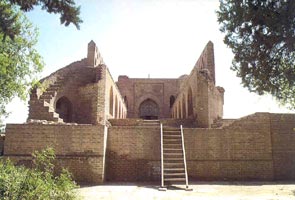 When Abu Jaafar Al mansour built Baghdad in
A.D. 762 it was a round city, with walls and four gates at an angle of
90 degrees for defensive purposes. Main administrative and religious
buildings were placed near the center for easy approach. Although the
capital was abandoned for Samarra in A.D. 1118 – 1135 , was the first
Caliph to build a wall on the eastern Russafa side of the city, which
remained until late in the 19th century. The eastern wall was very
thick, built from bricks, with several watch towers and a deep moat
connected with Tigris. The main gates were: Mua’dham (north) gate,
Dhafariya (Wastani) gate, Halaba (Talisman) gate, and Basaliya gate. The
only extant today is the wastani gate, near the tomb of Omer Sahrawardi
– just off Sheikh omer street. It is a high cylinder-shaped tower with a
ground circumference of 56 meters, 14.5 meters high, crowned with an
octagonal dome. On the north-west side it has a portal 3 meters wide
with a pointed arch, in front of which is a bridge across the moat. On
the south-west side of the tower is a door that leads to an even bigger
and higher bridge over the moat. In the course of the extensive
construction works undertaken lately, workers on the speedy way near
south gate recently hit upon the remnants of what transpired to have
been Halaba 9Talisman) gate, which was destroyed by the Ottomans in
1917. It had been last renewed some seven centuries earlier – in 1221:
it has now been preserved with care, to stand as another monument
telling a part of the history of Baghdad. When Abu Jaafar Al mansour built Baghdad in
A.D. 762 it was a round city, with walls and four gates at an angle of
90 degrees for defensive purposes. Main administrative and religious
buildings were placed near the center for easy approach. Although the
capital was abandoned for Samarra in A.D. 1118 – 1135 , was the first
Caliph to build a wall on the eastern Russafa side of the city, which
remained until late in the 19th century. The eastern wall was very
thick, built from bricks, with several watch towers and a deep moat
connected with Tigris. The main gates were: Mua’dham (north) gate,
Dhafariya (Wastani) gate, Halaba (Talisman) gate, and Basaliya gate. The
only extant today is the wastani gate, near the tomb of Omer Sahrawardi
– just off Sheikh omer street. It is a high cylinder-shaped tower with a
ground circumference of 56 meters, 14.5 meters high, crowned with an
octagonal dome. On the north-west side it has a portal 3 meters wide
with a pointed arch, in front of which is a bridge across the moat. On
the south-west side of the tower is a door that leads to an even bigger
and higher bridge over the moat. In the course of the extensive
construction works undertaken lately, workers on the speedy way near
south gate recently hit upon the remnants of what transpired to have
been Halaba 9Talisman) gate, which was destroyed by the Ottomans in
1917. It had been last renewed some seven centuries earlier – in 1221:
it has now been preserved with care, to stand as another monument
telling a part of the history of Baghdad.
-
Tell Harmal (Shadoboum):
About 9 kilometers to the east of the
capital, in new Baghdad. One of the sites of ancient Mesopotamia
civilization, dating back to Akkadian times and the Third Dynasty of Ur.
Around 1850 B.C., the city became an administrative center of the
Ashnunna kingdom. Large number of clay tablets were unearthed here,
covering a variety of subjects, including the Ashnunna laws, which
preceeded Hammurabi’s code by some two hundred years. The science
academy here, the firwst in the world, was mainly concerned with
mathimatics. Tablets have been discovered bearing complex mathematical
tables and theorems, including the so-called Euclid’s theorem with its
geometrical solution anticipating Euclid’s by about seventeen centuries.
-
Agargouf:
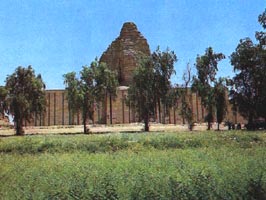 An ancient city, some 30 kms, to the north west of
Bagdad, built on a sumero-Babylonian plan in the 15th century B.C., by
king Kurigalzu, on an elongated tongue of natural limestone. Water came
to it from a large river (which branched of the Euphrates) called by the
Babylonian Bitty Inlil, one of the greatest in the ancientMesopotamian
pantheon. The same river was called in Arab times Isa river. The city
ziggurat, though partly ruined, commands the view with its 57 meters
height over the surrounding plain. Its base was 69 x 67 meters. Only the
lower level has survived, reinforced by an outer brick wall, with parts
of the inner mud-brick core still protruding high above it. To hold the
structure together matting and ropes were used every eight or nine
rows, which also protected it from seepage and damp. The first story has
three staircases in the middle, and two on the side. An ancient city, some 30 kms, to the north west of
Bagdad, built on a sumero-Babylonian plan in the 15th century B.C., by
king Kurigalzu, on an elongated tongue of natural limestone. Water came
to it from a large river (which branched of the Euphrates) called by the
Babylonian Bitty Inlil, one of the greatest in the ancientMesopotamian
pantheon. The same river was called in Arab times Isa river. The city
ziggurat, though partly ruined, commands the view with its 57 meters
height over the surrounding plain. Its base was 69 x 67 meters. Only the
lower level has survived, reinforced by an outer brick wall, with parts
of the inner mud-brick core still protruding high above it. To hold the
structure together matting and ropes were used every eight or nine
rows, which also protected it from seepage and damp. The first story has
three staircases in the middle, and two on the side.
-
Ctesiphon (Al-mada’in):
A historically important city on the east
bank of the Tigris 30 kilometers to the south of Baghdad. It dates back
originally to the 2nd century B.C. but amidst its extensive ruins stands
a fabulous arch built in the middle of the 3rd century of our era. It is
the largest single span brick built arch in the world: its construction
at the time must have been a miracle of architectural planning. A
descendant of ancient Mesopotamian structure in style, it embodied a
skilful development of temples and places of the third millennium B.C.,
when the front part of great buildings would consist of large halls
topped by high arches – as seen clearly at the entrances of Assyrian
cities. The ewan was the Arab extension of this style. In Arab Hatra the
ewan type was well known. Excavations in the temple of Allatu, built by
Sanatruq 1 (A.D. 165 – 190) have shown that the Ctesiphon ewan was an
exact copy of Hatra original. The arch is now 37 meters high with a
distance of 25.5 meters between the right and the left hand walls, and
48 meters deep. The lower part of the walls is 7 meters thick. Within a
short walking distance there is a museum of local remains where detailed
information is available. Open daily from 9.00 a.m. to 5.00 p.m. In the
town is also the shrine of Salman Al Farisi, one of the Companions of
the Prophet. A vast goat-hair tent in a green spot, furnished in Arab
style with local hand woven rugs and cushions, for visitors to rest and
have a cup of coffee. Some distance away there is a tourist hotel
together with a restaurant in the middle of an extensive garden. Another
tourist complex had been constructed nearby.
Diyala:
Tell Asmar (ancient Ishnunna):
capital of the Ishnunna Kingdom, which flourished in the old Babylonian
era. It is one of Diyala govern rate's historical sites.
|


